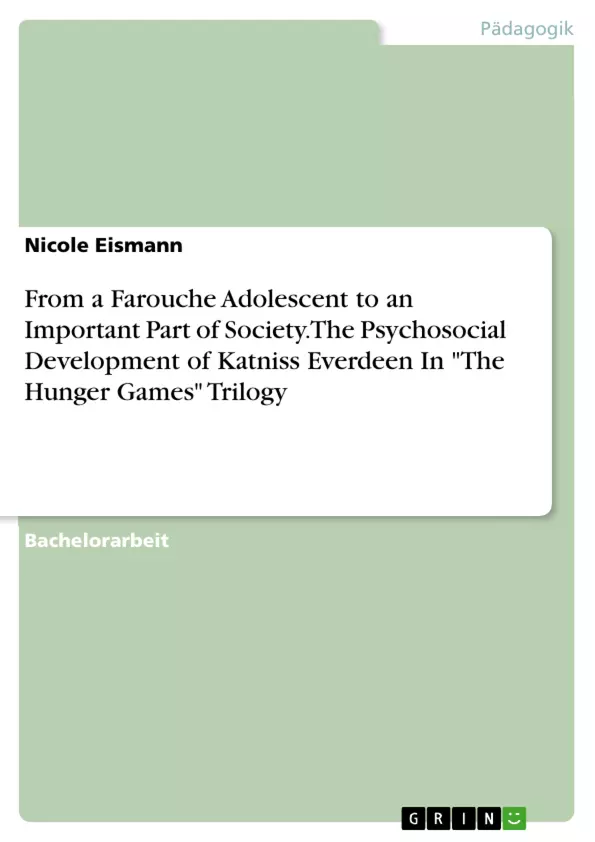The three books of Suzanne Collins' "The Hunger Games" trilogy have been published between 2008 and 2010 and tell the story of Panem, a North-American state of a dystopian future, and how a slowly upcoming rebellion, led by the protagonist Katniss Everdeen, helped the people to overcome the political oppression of a totalitarian government.
Throughout the first book, which appeared under the global title "The Hunger Games", the reader gets to know the main characters and the political and social situation in Panem, with the central problem of the Hunger Games as omnipresent fear for the entire society in the twelve districts. At the end of the first novel, after taking part in and winning the Hunger Games herself, the protagonist triggers more or less unwillingly a couple of happenings that slowly lead to the rebellious break out in the second book, which is appropriately called "Catching Fire", since it thematises the upcoming rebellious actions and how the Capitol tries to stop the rising number of rebels throughout the country.
The entire last volume of the trilogy, "Mockingjay", deals exclusively with the revolutionary actions and the slow fall of Panem's Capitol and the totalitarian system. The main target group of Collins' trilogy are young adult readers, however, it is also able to attract adults due to its complex plot and the profound representation of the topic.
Also, "The Hunger Games" trilogy is a hybrid novel, which cannot be assigned to one single genre as it includes aspects of a dystopia, romance and war literature; predominantly, however, it is a so called bildungsroman with two main focusses: On the one hand, there is a central socio-political statement, which has been created “very intentionally […] to characterize current and past world events”, according to the author herself. On the other hand, the novel deals intensively with the topic of growing up by highlighting both, normal psychological issues of teenagers, e.g. the first love, and the special circumstances, in which Katniss Everdeen grows up.
Inhaltsverzeichnis
- Introduction
- Katniss' personality in theory – a psychological framework
- Before the 74th Hunger Games – Katniss' life in district 12
- Katniss' self-image – her chosen role in society
- Katniss' family – the role of mother and sister
- Gale, Madge and the Hob – Katniss' small extra-familial world
- A life-changing challenge – the impact of Katniss' 1st Hunger Games
- After the reaping - 1st time outside the district
- Vulnerable girl in love or fighting machine? - Katniss' role inside the arena
- Peeta and Rue - first steps away from egocentrism
- Back at home - nothing stays the same
- The Quarter Quell – first time as team player?
- Katniss as bodyguard and rebel – a new identity and social challenges
- Pretending to be a team player - discrepancy between personal and collective aims inside the arena
- The rebellion a final revolution of Katniss' personality
- Growing into a new role – the Mockingjay spreads her wings
- A new life in District 13 – developments in war situation and their impact on Katniss' personality
- Freedom, family and femininity – the long way into a new life
- Conclusion
- Bibliography
- Primary Literature
- Secondary Literature
Zielsetzung und Themenschwerpunkte
Diese Bachelorarbeit befasst sich mit der psychosozialen Entwicklung der Protagonistin Katniss Everdeen in Suzanne Collins' "The Hunger Games"-Trilogie. Die Arbeit analysiert, wie Katniss eine feste Selbstidentität entwickelt und ihren Platz in der Gesellschaft findet. Dabei werden die politischen und sozialen Umstände, ihre persönlichen Erfahrungen und ihr soziales Umfeld als Einflussfaktoren auf diese Entwicklung untersucht.
- Die Auswirkungen der Hunger Games auf Katniss' Persönlichkeit und ihre Entwicklung
- Die Rolle von Familie und Freunden in Katniss' Leben und ihre Bedeutung für ihre Entwicklung
- Die Herausforderungen, denen Katniss im Laufe der Geschichte begegnet, und wie sie diese bewältigt
- Die Entwicklung von Katniss' Selbstbild und ihrer Rolle in der Gesellschaft
- Die Verbindung zwischen Katniss' persönlicher Entwicklung und dem politischen Kontext der Geschichte
Zusammenfassung der Kapitel
Die Arbeit beginnt mit einer Einführung in die "The Hunger Games"-Trilogie und stellt die wichtigsten Charaktere und den politischen Kontext vor. Anschließend wird ein psychologischer Rahmen für die Analyse von Katniss' Persönlichkeit geschaffen, indem wichtige psychologische Phänomene wie posttraumatische Belastungsstörung und schizoide Persönlichkeitsstörung definiert werden.
Kapitel 3 beleuchtet Katniss' Leben in Distrikt 12 vor den Hunger Games. Es werden ihre Selbsteinschätzung, ihre Rolle in der Gesellschaft, ihre Familie und ihr enger Freundeskreis analysiert. Kapitel 4 untersucht die Auswirkungen der ersten Hunger Games auf Katniss' Persönlichkeit und ihre Entwicklung. Es werden ihre Erfahrungen in der Arena, ihre Beziehungen zu Peeta und Rue sowie ihre Rückkehr nach Distrikt 12 analysiert.
Kapitel 5 befasst sich mit den zweiten Hunger Games, dem "Quarter Quell", und den Herausforderungen, denen Katniss als "Teamspieler" begegnet. Es werden ihre neue Rolle als Beschützerin und Rebellin sowie die Diskrepanz zwischen ihren persönlichen und kollektiven Zielen in der Arena untersucht. Kapitel 6 analysiert die Entwicklung von Katniss' Persönlichkeit während der Rebellion. Es werden ihre Rolle als "Mockingjay", ihre Erfahrungen in Distrikt 13 und ihre Suche nach Freiheit, Familie und Weiblichkeit untersucht.
Schlüsselwörter
Die Schlüsselwörter und Schwerpunktthemen des Textes umfassen die psychosoziale Entwicklung, Selbstidentität, soziale Rollen, politische und soziale Umstände, posttraumatische Belastungsstörung, schizoide Persönlichkeitsstörung, Familie, Freundschaft, Liebe, Rebellion, "The Hunger Games"-Trilogie, Katniss Everdeen, Suzanne Collins.
- Quote paper
- Nicole Eismann (Author), 2014, From a Farouche Adolescent to an Important Part of Society. The Psychosocial Development of Katniss Everdeen In "The Hunger Games" Trilogy, Munich, GRIN Verlag, https://www.grin.com/document/282194



